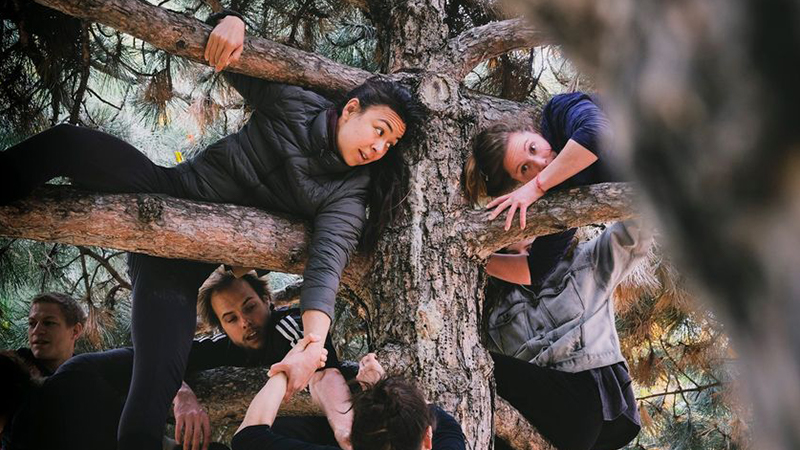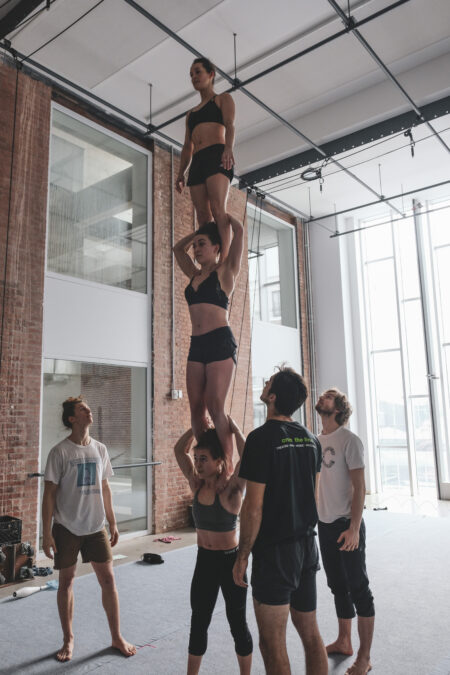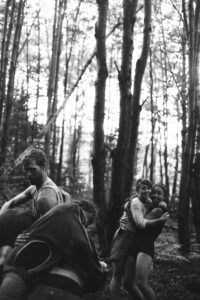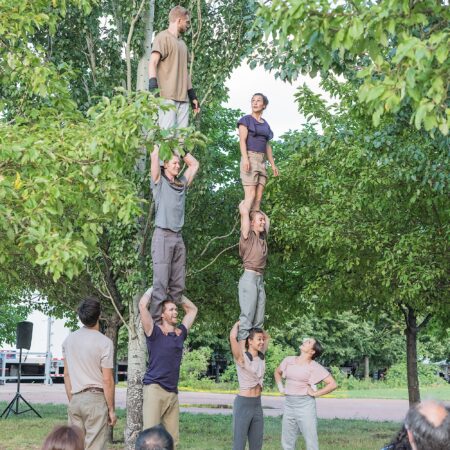Circus Performance Takes to the Woods of Jacob’s Pillow

Cirque Barcode and Acting for Climate, two Montréal-based circus companies, will be taking circus performance to the woods of Jacob’s Pillow in an exciting site-based work entitled Branché, presented August 13-15, 2021.
Marketing and Digital Media Intern Megan Ruffalo interviewed two of Cirque Barcode’s co-founders, Eric Bates and Tristan Nielsen, to learn more about how this work was created and the collaboration between these two circus companies, along with how they uphold their commitment to eco-responsibility.
Q: The site-specific performance you’re doing will be presented in a space you’ve never danced in before: the woods of Jacob’s Pillow. What is the process for creating a piece that relies so heavily on the environment around you?
Eric: In the beginning, we made this show up in the woods in Québec. The nature is not so different. It’s like an imaginary line that separates Canada and the U.S., but it’s all more or less the same thing between Massachusetts and the woods in Québec. Every time you’re gonna have different trees and you’re gonna have different forests. But the thing is, once you’ve walked in a few of these forests, you’re going to see a lot of similarities. So, we broke down the show by: “What do we need acrobatically for these different sections?” and: “How can we do that and deliver that to different performance spaces?”… [We] have a couple days to adapt, and we have some vocabulary we can incorporate and hopefully figure out how to make work in the specific trees there. Of course, what we’ve been finding, like up in Montreal, is that a lot of parks are trying to protect their trees, and so they don’t want anyone in trees whatsoever. So we adapted the show, and now we have a lot of ground-based material that doesn’t directly put weight on trees, a lot less than we initially had. Now we have a whole host of material that can be done almost without climbing any trees.
“I think the way humans understand the world is often in microcosmic stories. “
Q: How much of the work is choreographed versus improvised?
Eric: Almost the entire thing is choreographed. The thing that is probably the loosest is when the audience transitions from space to space. We have a narrative arc of what we want to happen in that transition [and] as long as they stick to the narrative arc, it’s fine however they want to do it. With circus, a lot of stuff you can’t just make up … Everyone needs to be on the same page for it to be safe. So while companies do have some improvised elements in shows, a lot of the technical acrobatic elements have to be rehearsed and choreographed, so everyone knows what’s going on to do it safely.
Q: What do rehearsals look like for this show?

Eric: The first time we ever did a workshop, it was indoors because it was the middle of winter in Montréal, which is very similar to Massachusetts. You’re not exactly romping around doing acrobatics in three feet of snow. So, we rehearsed inside and saw what we could do without using any apparatuses—in our case, trees. Then, as soon as we could, we got outside into the woods, which is amazing because it completely changes the space, and suddenly you have that feeling of when the lights go down in a theater. When you walk into the woods … there’s this environment, this ambiance that’s created that’s really cool when you see people doing circus or something unusual in that space. It looks like an actual theater.
Tristan: Since we’ve been creating shows, for quite a long time, one of my biggest qualms with creating and working in theaters is that it’s always dark. You go into these theaters and it’s beautiful outside and you spend twelve hours and you come out and it’s nighttime. It’s always a bummer. With creating Branché, it was actually really awesome that we were in the sun the whole time. It’s nice to spend the day creating outside.

Q: Can you tell me about your commitment to eco-responsibility? How has this manifested in previous productions and in this upcoming performance?
Eric: Branché has been our first real attempt to do something different … What we saw right away is that as a circus artist you’re constantly flying around the world and shining lights on yourself, which is frustrating if you care about the environment. It’s kind of like the opposite of what you want to be doing from an individual responsibility perspective. With Branché we said, “Okay, we’re not gonna take airplanes and we’re not gonna use lights.” Right away we started making three different casts for the show. So we have a cast in Europe, we have a cast in Montréal, and we have a cast of U.S. citizens … But with the goal that we could do only ground based travel, which is weird because usually you make a show, make sure it’s successful, and then start making more casts.
This was also the challenge to take something that we’re passionate about … and to figure out how we can do this just using our bodies, just using the tools we have? … It’s something that we haven’t seen addressed enough, especially in the circus space, but in the arts sector in general.
Q: Can you tell me about the relationship between Cirque Barcode and Acting For Climate Montréal and how you two came to be working with each other?
Eric: Unrelated to Branché, [Acting for Climate] does physical movement circus workshops. They were hosting one of those back in November 2019 that I participated in. I think we met at the Climate March in Montréal … We met at that and did that workshop together. We started talking [and] I said that I wanted to make a circus show about the environment. It turned out that Nathan, one of the co-founders of Acting for Climate Montréal and the guy hosting the workshop at the time, also wanted to do that … Right away we started talking. Then, by that winter, we had started writing grants and started getting people together. We hosted our first workshop for Branché specifically in February of 2020. That was really the way we began to work together. Once you decide you’re making a show together, your lives are pretty much entwined from that point on.

Q: What is the significance of the title Branché?
Eric: Branché in French can mean “connected,” but in the same way can also mean “hip” or “trendy,” almost … Nathan had the idea for the title right away, especially because we had trees. It kind of sounds like ‘branch’ as well … We just liked the multiple significances of the idea that this could be something that is hip and trendy but kind of moving towards a new normal that hopefully people care about the environment more and consider it in their actions.
Experience Branché Friday August 13 through Sunday August 15 on the Pillow grounds ($25). Visit the event page to learn more.
Written by Megan Ruffalo. Published August 2021.